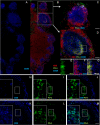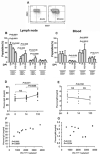Spatial alterations between CD4(+) T follicular helper, B, and CD8(+) T cells during simian immunodeficiency virus infection: T/B cell homeostasis, activation, and potential mechanism for viral escape
- PMID: 22387550
- PMCID: PMC3311732
- DOI: 10.4049/jimmunol.1103138
Spatial alterations between CD4(+) T follicular helper, B, and CD8(+) T cells during simian immunodeficiency virus infection: T/B cell homeostasis, activation, and potential mechanism for viral escape
Abstract
HIV/SIV infections induce chronic immune activation with remodeling of lymphoid architecture and hypergammaglobulinemia, although the mechanisms leading to such symptoms remain to be fully elucidated. Moreover, lymph nodes have been highlighted as a predilection site for SIV escape in vivo. Following 20 rhesus macaques infected with SIVmac239 as they progress from pre-infection to acute and chronic infection, we document for the first time, to our knowledge, the local dynamics of T follicular helper (T(FH)) cells and B cells in situ. Progression of SIV infection was accompanied by increased numbers of well-delineated follicles containing germinal centers (GCs) and T(FH) cells with a progressive increase in the density of programmed death-1 (PD-1) expression in lymph nodes. The rise in PD-1(+) T(FH) cells was followed by a substantial accumulation of Ki67(+) B cells within GCs. However, unlike in blood, major increases in the frequency of CD27(+) memory B cells were observed in lymph nodes, indicating increased turnover of these cells, correlated with increases in total and SIV specific Ab levels. Of importance, compared with T cell zones, GCs seemed to exclude CD8(+) T cells while harboring increasing numbers of CD4(+) T cells, many of which are positive for SIVgag, providing an environment particularly beneficial for virus replication and reservoirs. Our data highlight for the first time, to our knowledge, important spatial interactions of GC cell subsets during SIV infection, the capacity of lymphoid tissues to maintain stable relative levels of circulating B cell subsets, and a potential mechanism for viral reservoirs within GCs during SIV infection.
Figures







References
-
- Welsh RM, Selin LK, Szomolanyi-Tsuda E. Immunological memory to viral infections. Annu. Rev. Immunol. 2004;22:711–743. - PubMed
-
- Yu D, Vinuesa CG. The elusive identity of T follicular helper cells. Trends Immunol. 2010;31:377–383. - PubMed
-
- Vogelzang A, McGuire HM, Yu D, Sprent J, Mackay CR, King C. A fundamental role for interleukin-21 in the generation of T follicular helper cells. Immunity. 2008;29:127–137. - PubMed
Publication types
MeSH terms
Substances
Grants and funding
LinkOut - more resources
Full Text Sources
Other Literature Sources
Research Materials
Miscellaneous

